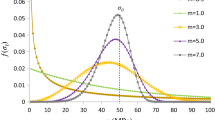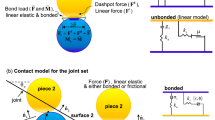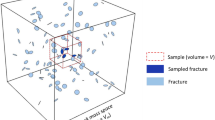Abstract
The upscaling of mechanical properties of fractured media requires the definition of an appropriate size for the Representative Elementary Volume (REV). Because of the stochastic nature of the fracture networks, the REV size is not deterministic and should be defined based on the variability of the equivalent properties. This work presents a new general methodology to define the size of the REV for the geometrical and elastic moduli of fractured media. Following previous works on heterogeneous materials, the decision criterion is based on the precision error that arises from the statistical theory of samples. The proposed methodology also relies on the use of the Central Limit Theorem (CLT) to assess the REV of fractured rocks. The CLT is shown to theoretically apply to both the geometrical and the elastic equivalent properties. From that observation, a general equation is drawn to predict the variance of an equivalent property for any REV candidate size, provided that the variance for one size only is known. These concepts are tested using numerous finite element simulations to obtain the distribution of the equivalent elastic moduli of two-dimensional samples containing two fracture networks previously studied for their elastic properties. These properties are confirmed to tend to a normal distribution, as stated by the CLT. Also, the standard deviations associated with the tested REV sizes were predicted with accuracy from the standard deviation obtained in the numerical simulations of only one proper reference volume. The mechanical REV was compared with the geometrical REV, which is based on the first invariant of the fracture tensor. In addition, to reduce computational costs, a procedure to reduce the number of simulations of the reference volume was proposed. A preliminary verification of the applicability of the methodology to non-elastic problems was made. Proper predictions were obtained for the standard deviation of the compression strength calculated in two studies that considered, altogether, both two-dimensional and three-dimensional samples, as well as plastic and damage models.




















Similar content being viewed by others
References
Barton N (2002) Some new Q-value correlations to assist in site characterisation and tunnel design. Int J Rock Mech Min Sci 39:185–216
Caspari E, Milani M, Rubino J, Müller T, Quintal B, Holliger K (2016) Numerical upscaling of frequency-dependent p- and s-wave moduli in fractured porous media. Geophys Prospect 64:1166–1179
Duncan JM, Goodman RE (1968) Finite element analyses of slopes in jointed rock: a report of an investigation. Tech. Rep. S-68-3, U.S. Army Corps of Engineers
Esmaieli K, Hadjigeorgiou J, Grenon M (2010) Estimating geometrical and mechanical REV based on synthetic rock mass models at Brunswick Mine. Int J Rock Mech Min Sci 47:915–926
Farahmand K, Vazaios I, Diederichs MS, Vlachopoulos N (2018) Investigating the scale-dependency of the geometrical and mechanical properties of a moderately jointed rock using a synthetic rock mass (SRM) approach. Comput Geotech 95:162–179
Goodman R, Taylor R, Brekke T (1968) A model for the mechanics of jointed rock. J Soil Mech Found Div 94:105–115
Harthong B, Scholtès L, Donzé FV (2012) Strength characterization of rock masses using a coupled DEM-DFN model. Geophys J Int 191(2):467–480
Hoek E, Brown ET (1997) Practical estimates of rock mass strength. Int J Rock Mech Min Sci 34(8):1165–1186
JianPing Y, WeiZhong C, DianSen Y, JingQiang Y (2015) Numerical determination of strength and deformability of fractured rock mass by FEM modeling. Comput Geotech 64:20–31
Jones TA (1969) Skewness and kurtosis as criteria of normality in observed frequency distributions. J Sediment Res 39(4):1622–1627
Kachanov M (1980) Continuum model of medium with cracks. J Eng Mech Div ASCE 106:1039–1051
Kanit T, Forest S, Galliet I, Mounoury V, Jeulin D (2003) Determination of the size of the representative volume element for random composites: statistical and numerical approach. Int J Solids Struct 40:3647–3679
Kulatilake PHSW, Wang S, Stephansson O (1993) Effect of finite size joints on the deformability of jointed rock in three dimensions. Int J Rock Mech Min Sci Geomech 30:479–501
Kulatilake PHSW, Malama B, Wang J (2001) Physical and particle flow modeling of jointed rock block behavior under uniaxial loading. Int J Rock Mech Min Sci 38:641–657
Liu Y, Wang Q, Chen J, Zhan Song S J, Han X (2018) Determination of geometrical revs based on volumetric fracture intensity and statistical tests. Appl Sci 8(800):1–18
Min K, Jing L (2003) Numerical determination of the equivalent elastic compliance tensor for fractured rock masses using the distinct element method. Int J Rock Mech Min Sci 40:795–816
Nguyen VP (2014) An open source program to generate zero-thickness cohesive interface elements. Adv Eng Softw 74:27–39
Ni P, Wang S, Wang C, Zhang S (2017) Estimationf of the REV size for fractured rock mass based on damage coefficient. Rock Mech Rock Eng 50:555–570
Oda M (1982) Fabric tensor for discontinuous geological materials. Soils Found 22:96–108
Oda M (1988) A new method for evaluating the representative elementary volume based on joint survey of rock masses. Can Geotech J 25:440–447
Oda M, Suzuki K, Maeshibu T (1984) Elastic compliance for rock-like materials with random cracks. Soils Found 24:27–40
Pouya A, Ghoreychi M (2001) Determination of rock mass strength properties by homogenization. Int J Numer Anal Methods Geomech 25(13):1285–1303
Rasmussen LL, de Farias MM, de Assis AP (2018) Extended Rigid Body Spring Network method for the simulation of brittle rocks. Comput Geotech 99:31–41
Schultz R (1996) Relative scale and the strength and deformability of rock masses. J Struct Geol 18(9):1139–1149
Shewchuk JR (1996) Triangle: engineering a 2D quality mesh generator and Delaunay triangulator. In: Applied computational geometry: towards geometric engineering, lecture notes in computer science, vol 1148. Springer, pp 203–222, from the First ACM workshop on applied computational geometry
Wang X, Cai M (2020) A DFN-DEM multi-scale modeling approach for simulating tunnel excavation response in jointed rock masses. Rock Mech Rock Eng 53(3):1053–1077. https://doi.org/10.1007/s00603-019-01957-8
Wang S, Huang R, Gamage Ni R P, Zhang M (2013) Fracture behavior of intact rock using acoustic emission: experimental observation and realistic modeling. Geotech Test J 36(6):903–914
Wu Q, Kulatilake PHSW (2012) REV and its properties on fracture system and mechanical properties, and an orthotropic constitutive model for a jointed rock mass in a dam site in china. Comput Geotech 43:124–142
Yang JP, Chen WZ, Dai YH, Yu HD (2014) Numerical determination of elastic compliance tensor of fractured rock masses by finite element modeling. Int J Rock Mech Min Sci 70:474–482
Zhang L, Einstein H (2000) Estimating the intensity of rock discontinuities. Int J Rock Mech Min Sci 37:819–837
Zhang W, Chen JP, Liu C, Huang R, Li M, Zhang Y (2011) Determination of geometrical and structural representative volume elements at the Baihetan dam site. Rock Mech Rock Eng 45:409–419
Acknowledgements
This study was financed in part by the Coordenação de Aperfeiçoamento de Pessoal de Nível Superior – Brasil (CAPES) – Finance Code 001.
Author information
Authors and Affiliations
Corresponding author
Additional information
Publisher's Note
Springer Nature remains neutral with regard to jurisdictional claims in published maps and institutional affiliations.
Appendices
Appendix
A Calculation of the equivalent elastic properties
The stress-strain relationship for linear elastic anisotropic media can be expressed as:
We consider here the equivalent compliance tensor of a fractured rock mass where the intact rock has Young modulus \(E_\mathrm{r}\) and Poisson ratio \(\nu _\mathrm{r}\). In the two-dimensional space, the constitutive tensor \(S_{ijkl}\) can be expressed in terms of the equivalent elastic moduli as:
where \(E_i\) are the elastic moduli, \(\nu _{ij}\) are Poisson ratios, \(\eta _{i,jk}\) are coefficients of mutual inflience of the first kind and \(\eta _{ij,k}\) are coefficients of mutual influence of the second kind. Considering that the fractures have strikes in the direction z, they do not affect the deformations in this direction; thus, \(E_z\) = \(E_r\), \(\nu _{xz} = \nu _{yz} = \nu _{r}\), and the components \(S_{31}\), \(S_{32}\) and \(S_{33}\) are then equal to those of the compliance tensor of the intact rock. Also, since the shear stress \(\sigma _{xy}\) does not affect deformations in z, \(S_{34}\) is equal to zero. Considering the symmetry conditions, \(S_{13} = S_{31}\), \(S_{23} = S_{32}\) and \(S_{34} = S_{43}\). Hence, there are 7 components of the tensor which are known a priori because of the assumption of bidimensionality.
For plane-strain conditions, the relationship in (16) reduces to:
Three linearly-independent boundary conditions are necessary to obtain the unknowns of the elastic compliance tensor. In this paper, we used the applied stresses illustrated in Fig. 7. The resulting displacements \(u_i\) (\(i= x, y\)) at the boundaries were used to calculate the homogenized strains as:
The stress \(\sigma _z\) can be calculated from the applied stresses and the properties of the intact rock as:
And the tensor components are calculated using (20) and the system formed by lines 1, 2 and 4 in (18)
Rights and permissions
About this article
Cite this article
Loyola, A.C., Pereira, JM. & Cordão Neto, M.P. General Statistics-Based Methodology for the Determination of the Geometrical and Mechanical Representative Elementary Volumes of Fractured Media. Rock Mech Rock Eng 54, 1841–1861 (2021). https://doi.org/10.1007/s00603-021-02374-6
Received:
Accepted:
Published:
Issue Date:
DOI: https://doi.org/10.1007/s00603-021-02374-6




